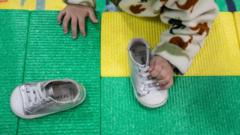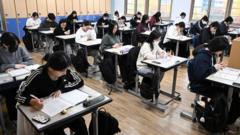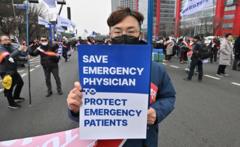In the heart of South Korea, infertility treatments are experiencing an unprecedented boom as the nation firmly faces the consequences of its declining birth rate. Residents, like Kim Mi-ae, are experiencing the strain on resources, battling long wait times at fertility clinics as the country attempts to address its demographic predicament. This spike in demand for services relates closely to changing societal norms where a younger generation seeks more control over their reproductive futures. Recent statistics reveal a dramatic increase in fertility treatments, with numbers soaring nearly 50% over four years, highlighting the urgency and the evolving perception of having children.
**Fertility Clinics Thrive in South Korea Amid Declining Birth Rates**

**Fertility Clinics Thrive in South Korea Amid Declining Birth Rates**
As South Korea grapples with the world's lowest birth rates, the demand for fertility clinics is witnessing a significant surge, reflecting a shift in societal attitudes towards family planning.
Seoul’s birth rate, while historically low at 0.72 in 2023, showed a slight rebound to 0.75 in 2024, generating a glimmer of hope amidst the ongoing crisis. Many experts believe that this upturn may signal a change in attitudes surrounding family life, as traditional aspirations intertwine with modern challenges. The pressures of financial stability, long working hours, and societal expectations persist, frequently obstructing desired family growth. However, government initiatives to support fertility clinics, including subsidizing egg-freezing and IVF treatment costs, aim to alleviate some of these burdens.
Women, on average waiting until age 33.6 to have children, cite various obstacles hindering their reproductive journeys, yet a burgeoning noble desire remains to start families. Stories from women like Park Soo-in and Jang Sae-ryeon shed light on the reality of navigating the rocky path of fertility treatments, highlighting not only emotional turmoil but also the staggering financial challenges involved. While the government adopts measures to foster family growth, the psychological and institutional barriers these women face underline a complicated yet hopeful narrative for South Korea’s demographic future. Without doubt, the evolving landscape of fertility treatments stands as both a reflection of new societal norms and a beacon of hope for many yearning for parenthood in a time of uncertainty.
Women, on average waiting until age 33.6 to have children, cite various obstacles hindering their reproductive journeys, yet a burgeoning noble desire remains to start families. Stories from women like Park Soo-in and Jang Sae-ryeon shed light on the reality of navigating the rocky path of fertility treatments, highlighting not only emotional turmoil but also the staggering financial challenges involved. While the government adopts measures to foster family growth, the psychological and institutional barriers these women face underline a complicated yet hopeful narrative for South Korea’s demographic future. Without doubt, the evolving landscape of fertility treatments stands as both a reflection of new societal norms and a beacon of hope for many yearning for parenthood in a time of uncertainty.





















